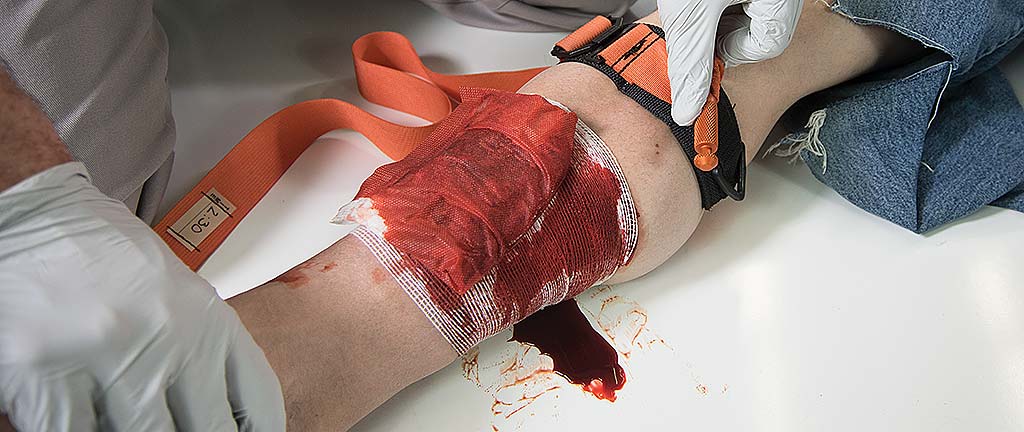With the release of the G2015 ASHI and MEDIC First Aid training program materials, training in the use of a tourniquet has become an integral part of the control of bleeding.
When to Use a Tourniquet
A tourniquet should be used if direct pressure is unable to control bleeding on a limb.
A tourniquet can also be considered as a primary step to control severe limb bleeding when it is clear direct pressure cannot be applied effectively, such as in a mass casualty event, for a person with large or multiple injuries, in a dangerous environment, or for an inaccessible wound.
Tourniquets and the G2015 Programs
In the “Control of Bleeding” section of ASHI and MEDIC First Aid training programs, the instructor demonstration for the skill includes direct pressure, pressure bandage, and use of a commercial tourniquet.
The demonstration of commercial tourniquet use is important to better familiarize people with them and to help overcome the fear and stigma associated with tourniquets.
Some recent arguments about tourniquets include – “I (or my students) will never have a need for a tourniquet.” Or, “We’ll never have tourniquets in our first aid kits, so we would never have one available to use.”
If you think back to automated external defibrillators (AEDs) just a few years ago, these arguments may sound familiar. We all must admit that AEDs can and do make a difference. And with workplace and public access defibrillation programs, AEDs are found in more and more places.
For those that say they will never have a need for a tourniquet – think of the natural disasters or mass casualty events in recent years. The use of tourniquets helped prevent death from massive blood loss.
For those that say they will never have a tourniquet available to use – In June 2015, a new ANSI/ISEA standard was introduced that included a tourniquet in Class B workplace first aid kits.
Even the highest levels of the federal government have recognized the importance of increasing the awareness and knowledge of the public about bleeding control. On October 6, 2015, the White House Administration launched the “Stop the Bleed” campaign to provide people with the tools and knowledge to stop life-threatening bleeding in the event of an emergency.
There have even been discussions of creating public access to bleeding control kits similar to what has happened with AEDs.
For those who are still concerned about the use of tourniquets – there is no doubt that, for many years, there has been a stigma or even outright fear associated with tourniquets. One of the more prevalent fears is that prolonged use of a tourniquet would lead to amputation of the limb. However, I think you’ll agree that it’s “better to lose a limb than lose a life.”
That being said, these fears may actually be unfounded. As the Emergency Physicians Monthly points out:
The most recent studies indicate that the tourniquet is safer than previously described. In 2008, Kragh et al. studied 232 patients with 309 limbs that had tourniquets applied and determined that there were no amputations resulting from tourniquet use. The enhanced safety of the tourniquet is in no doubt due not only to technical advances in their design but also because transport times to surgeons have been greatly reduced.
Tourniquets are again an important part of the overall strategy for bleeding control. The information about tourniquets and a demonstration of their use, provided in ASHI and MEDIC First Aid training programs, should help to increase the understanding and potentially allay any fears. For those desiring more hands-on practice on tourniquet use, there is supplemental topic information available in the program materials that will allow instructors to integrate this into their classes.
Dr. James Phillips to Speak on Bleeding Control at HSI Conference
We’re excited to announce that Dr. James Phillips, MD, is returning to the HSI Conference stage! He will be presenting on “Public Education in Bleeding Control and Tourniquet Use” at Spark 2016, the HSI International Conference in Phoenix.
Dr. Phillips is a board-certified Emergency Medicine specialist from Boston, MA. He is a full-time academic faculty member at Beth Israel Deaconess Medical Center and an instructor at Harvard Medical School.
Dr. Phillips’ interests include disaster medicine, tactical medicine, and the role of medicine in counterterrorism. He has recently authored textbook chapters on active shooter response, improvised explosive devices, structure fires, and the medical treatment of hostages.
Join us at the Point Hilton Squaw Peak Resort in Phoenix, AZ from October 24-26 for Spark 2016! Registration is now open.







.png?width=600&name=HSI-CTA-EmergencyCareTraining%20(1).png)











Comments